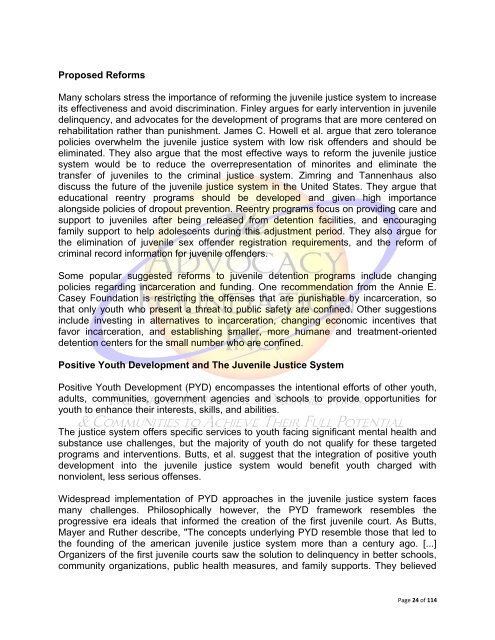African-American Youth in The Juvenile Justice System
African-American Youth in The Juvenile Justice System
African-American Youth in The Juvenile Justice System
Create successful ePaper yourself
Turn your PDF publications into a flip-book with our unique Google optimized e-Paper software.
Proposed Reforms<br />
Many scholars stress the importance of reform<strong>in</strong>g the juvenile justice system to <strong>in</strong>crease<br />
its effectiveness and avoid discrim<strong>in</strong>ation. F<strong>in</strong>ley argues for early <strong>in</strong>tervention <strong>in</strong> juvenile<br />
del<strong>in</strong>quency, and advocates for the development of programs that are more centered on<br />
rehabilitation rather than punishment. James C. Howell et al. argue that zero tolerance<br />
policies overwhelm the juvenile justice system with low risk offenders and should be<br />
elim<strong>in</strong>ated. <strong>The</strong>y also argue that the most effective ways to reform the juvenile justice<br />
system would be to reduce the overrepresentation of m<strong>in</strong>orites and elim<strong>in</strong>ate the<br />
transfer of juveniles to the crim<strong>in</strong>al justice system. Zimr<strong>in</strong>g and Tannenhaus also<br />
discuss the future of the juvenile justice system <strong>in</strong> the United States. <strong>The</strong>y argue that<br />
educational reentry programs should be developed and given high importance<br />
alongside policies of dropout prevention. Reentry programs focus on provid<strong>in</strong>g care and<br />
support to juveniles after be<strong>in</strong>g released from detention facilities, and encourag<strong>in</strong>g<br />
family support to help adolescents dur<strong>in</strong>g this adjustment period. <strong>The</strong>y also argue for<br />
the elim<strong>in</strong>ation of juvenile sex offender registration requirements, and the reform of<br />
crim<strong>in</strong>al record <strong>in</strong>formation for juvenile offenders.<br />
Some popular suggested reforms to juvenile detention programs <strong>in</strong>clude chang<strong>in</strong>g<br />
policies regard<strong>in</strong>g <strong>in</strong>carceration and fund<strong>in</strong>g. One recommendation from the Annie E.<br />
Casey Foundation is restrict<strong>in</strong>g the offenses that are punishable by <strong>in</strong>carceration, so<br />
that only youth who present a threat to public safety are conf<strong>in</strong>ed. Other suggestions<br />
<strong>in</strong>clude <strong>in</strong>vest<strong>in</strong>g <strong>in</strong> alternatives to <strong>in</strong>carceration, chang<strong>in</strong>g economic <strong>in</strong>centives that<br />
favor <strong>in</strong>carceration, and establish<strong>in</strong>g smaller, more humane and treatment-oriented<br />
detention centers for the small number who are conf<strong>in</strong>ed.<br />
Positive <strong>Youth</strong> Development and <strong>The</strong> <strong>Juvenile</strong> <strong>Justice</strong> <strong>System</strong><br />
Positive <strong>Youth</strong> Development (PYD) encompasses the <strong>in</strong>tentional efforts of other youth,<br />
adults, communities, government agencies and schools to provide opportunities for<br />
youth to enhance their <strong>in</strong>terests, skills, and abilities.<br />
<strong>The</strong> justice system offers specific services to youth fac<strong>in</strong>g significant mental health and<br />
substance use challenges, but the majority of youth do not qualify for these targeted<br />
programs and <strong>in</strong>terventions. Butts, et al. suggest that the <strong>in</strong>tegration of positive youth<br />
development <strong>in</strong>to the juvenile justice system would benefit youth charged with<br />
nonviolent, less serious offenses.<br />
Widespread implementation of PYD approaches <strong>in</strong> the juvenile justice system faces<br />
many challenges. Philosophically however, the PYD framework resembles the<br />
progressive era ideals that <strong>in</strong>formed the creation of the first juvenile court. As Butts,<br />
Mayer and Ruther describe, "<strong>The</strong> concepts underly<strong>in</strong>g PYD resemble those that led to<br />
the found<strong>in</strong>g of the american juvenile justice system more than a century ago. [...]<br />
Organizers of the first juvenile courts saw the solution to del<strong>in</strong>quency <strong>in</strong> better schools,<br />
community organizations, public health measures, and family supports. <strong>The</strong>y believed<br />
Page 24 of 114

















